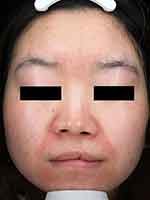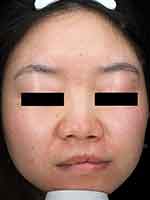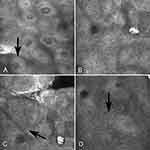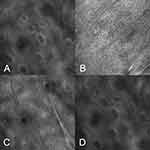Back to Journals » Clinical, Cosmetic and Investigational Dermatology » Volume 16
Reflectance Confocal Microscopy of Adult Periorificial Dermatitis: A Case Report
Authors Shen S, Feng J, Song X, Xiang W
Received 3 May 2023
Accepted for publication 12 July 2023
Published 20 July 2023 Volume 2023:16 Pages 1865—1869
DOI https://doi.org/10.2147/CCID.S419756
Checked for plagiarism Yes
Review by Single anonymous peer review
Peer reviewer comments 2
Editor who approved publication: Dr Jeffrey Weinberg
Sihao Shen,1 Jiangfeng Feng,1 Xiuzu Song,2 Wenzhong Xiang2
1Department of Dermatology, Hangzhou Third People’s Hospital, Zhejiang Chinese Medical University, Hangzhou, People’s Republic of China; 2Department of Dermatology, Hangzhou Third People’s Hospital, Affiliated Hangzhou Dermatology Hospital, Zhejiang University School of Medicine, Hangzhou, People’s Republic of China
Correspondence: Wenzhong Xiang, Department of Dermatology, Hangzhou Third People’s Hospital; Affiliated Hangzhou Dermatology Hospital, Zhejiang University School of Medicine, Westlake Ave 38, Hangzhou, 310009, People’s Republic of China, Tel +86 13588004268, Email [email protected]
Abstract: Periorificial dermatitis (PD) is an inflammatory disorder of the facial skin that mainly occurs around the mouth and manifests as erythema, papules, pustules, scales and other lesions. Special attention is needed in the clinical diagnosis of PD to distinguish it from acne, seborrheic dermatitis (SD), granulomatous rosacea (GR), sarcoidosis and childhood granulomatous periorificial dermatitis (CGPD). We used reflectance confocal microscopy (RCM) images of a patient with PD to assist in the diagnosis of PD. RCM of PD showed slight oedema of the spinous layer. Numerous dendritic cells, scattered hair follicular keratotic plugging and hair follicle dilatation were observed. The dilation and congestion of superficial dermis blood vessels, an increasing vascular density and accelerated blood flow, and a greater abundance of infiltrated inflammatory cells were also detected.
Keywords: periorificial dermatitis, reflectance confocal microscopy, acne, seborrheic dermatitis, granulomatous rosacea, sarcoidosis, childhood granulomatous periorificial dermatitis
Introduction
Periorificial dermatitis (PD) is an inflammatory disorder of the facial skin that mainly occurs around the mouth and manifests as erythema, papules, pustules, scales and other lesions, most often in women aged 16–50.1 It was first described by Frumess and Lewis in 1957 as a type of cyclic dermatitis.2 To date, the exact pathogenesis of PD is not clear. Common causes include the topical use of glucocorticoids and exaggerated skincare, but other factors, such as bacterial or fungal infection and the application of fluoride toothpaste, are also worth discussing.3
Acne and seborrheic dermatitis (SD) are common and important differential diagnoses of PD. Attention is needed in the diagnosis of PD to distinguish it from these diseases, as well as granulomatous rosacea (GR), sarcoidosis and childhood granulomatous periorificial dermatitis (CGPD).4 Clinically, patients tend to refuse skin biopsy; therefore, noninvasive methods for differential diagnosis will be more practical.
Reflectance confocal microscopy (RCM) is a noninvasive imaging method that has been shown to provide sufficient data to support the clinical diagnosis of inflammatory and pigmented skin diseases.5 PD is a benign and self-limiting disease; thus, overdiagnosis should be avoided. The combination of RCM with clinical features will facilitate differential diagnosis. RCM does not cause discomfort to the patient and allows repeated examination of the same skin area. Currently, there are no studies on RCM in PD, and we provide a case to fill this research gap.
Case Report
A 25-year-old young woman presented with periorificial erythema papules for one year, with a tight feeling, no itching, and gradual aggravation. The patient denied the use of creams containing steroid hormones and did not use fluoridated toothpaste. Dermatological examination revealed erythema and papules around the wing of the nose and mouth without scales. Approximately 5 mm of skin area separated the lesions, and the lip was not invaded (Figure 1). The results of all routine tests were within the normal range.
 |
Figure 1 Facial image of the PD patient. Erythema and papules can be seen around the wing of nose and mouth without scales. |
A trained professional performed RCM imaging on this patient (Vivascope 1500®; Lucid Technologies, Henrietta, N.Y., USA) using an objective lens with 30x magnification. The lateral resolution was 0.5~1.0 μm, and the axial resolution was 3~55 μm.
RCM images revealed that the skin lesions were thinner than the surrounding normal skin. The spinous layer showed slight oedema. Many dendritic cells, scattered hair follicular keratotic plugging and hair follicle dilatation were observed. There was no pigmentation in the epidermis and no melanophages in the dermis. The dilation and congestion of superficial dermis blood vessels, an increasing vascular density and accelerated blood flow, and a greater abundance of infiltrated inflammatory cells were also detected (Figure 2).
Since the patient refused skin biopsy, we did not perform this examination. According to previous studies, the histopathological findings of PD are mainly perifollicular lymphocytic and perivascular infiltration. In addition, epidermal oedema and keratosis, along with vascular dilatation, are seen in the dermis.2,4 The findings of RCM corresponded substantially with the histopathology.
Treatment included topical 0.03% tacrolimus cream and vitamin E cream and 0.1 g oral doxycycline twice a day. The erythema and papules mostly subsided after a month (Figure 3). RCM examination found no obvious oedema in the spinous layer, vascular dilation and congestion were improved, and no inflammatory cells were detected in the dermis (Figure 4).
 |
Figure 3 Facial image of the PD patient after treatment. The erythema and papules around the wing of nose and mouth were significantly improved. |
Discussion
The clinical manifestations of PD are sometimes clinically similar to those of acne, SD, GR, LMDF and CGPD, and RCM can assist in diagnosis. Acne tends to occur in young patients, and under RCM, comedos (enlarged infundibula with a hyperkeratotic bright border), papules (massive inflammatory cell infiltration), and pustules (hyperreflecting inflammatory infiltration in the pustular cavity) can be found.6 SD usually occurs in the brow, scalp and nasolabial region where oil production is strong, and the main symptom is scaling. Features of SD that can be observed under RCM include spongiosis, dermal inflammation and the horizontal direction of dilating blood vessels.7 RCM can show the characteristic high density of demodex mites in the upper part of hair follicles of GR patients.8 Although demodex mites can be seen in PD, they are rare. Moreover, the bright beaded-like structures observed on RCM, corresponding to reticulin fibres overlying granulomas, are effective for the diagnosis of sarcoidosis.9 In CGPD, dermal infiltration of epidermoid histiocytes can be observed under RCM, which, although not specific, is highly suggestive of granulomatous disease.10
Conclusion
In conclusion, we report RCM features of an adult patient with PD that, combined with clinical manifestations, can aid in differential diagnosis without the need for skin biopsy.
Consent
Written informed consent was obtained from the patient for the publication of this case report and any accompanying images. Institutional approval was not required for this case study.
Acknowledgments
We thank the patient for her permission to publish this information. This work was supported by the Hangzhou biomedical and health industry development support project (2021WJCY159), Hangzhou medical key discipline construction project (No [37]21-3) and Hangzhou health science and technology key project (No 20220054).
Disclosure
The authors report no conflicts of interest related to this work.
References
1. Nguyen V, Eichenfield LF. Periorificial dermatitis in children and adolescents. J Am Acad Dermatol. 2006;55(5):781–785. doi:10.1016/j.jaad.2006.05.031
2. Lipozencic J, Ljubojevic S. Perioral dermatitis. Clin Dermatol. 2011;29(2):157–161. doi:10.1016/j.clindermatol.2010.09.007
3. Charnowski S, Wollenberg A, Reinholz M. Perioral dermatitis successfully treated with topical ivermectin. Ann Dermatol. 2019;31(Suppl):S27–S28. doi:10.5021/ad.2019.31.S.S27
4. Lee GL, Zirwas MJ. Granulomatous rosacea and periorificial dermatitis: controversies and review of management and treatment. Dermatol Clin. 2015;33(3):447–455. doi:10.1016/j.det.2015.03.009
5. Xiang W, Xu A, Xu J, Bi Z, Shang Y, Ren Q. In vivo confocal laser scanning microscopy of hypopigmented macules: a preliminary comparison of confocal images in vitiligo, nevus depigmentosus and postinflammatory hypopigmentation. Lasers Med Sci. 2010;25(4):551–558. doi:10.1007/s10103-010-0764-2
6. Alma A, Sticchi A, Chello C, et al. Dermoscopy, reflectance confocal microscopy and optical coherence tomography features of acne: a systematic review. J Clin Med. 2022;11(7):1783. doi:10.3390/jcm11071783
7. Agozzino M, Berardesca E, Donadio C, et al. Reflectance confocal microscopy features of seborrheic dermatitis for plaque psoriasis differentiation. Dermatology. 2014;229(3):215–221. doi:10.1159/000363289
8. Sattler EC, Hoffmann VS, Ruzicka T, Braunmuhl TV, Berking C. Reflectance confocal microscopy for monitoring the density of Demodex mites in patients with rosacea before and after treatment. Br J Dermatol. 2015;173(1):69–75. doi:10.1111/bjd.13783
9. Pasquali P, Gonzalez S, Fortuno A, Freites-Martinez A. In-vivo assessment of a case of cutaneous sarcoidosis using reflectance confocal microscopy. An Bras Dermatol. 2019;94(1):93–95. doi:10.1590/abd1806-4841.20197315
10. Lacarrubba F, Verzi AE, Caltabiano R, Puglisi DF, Micali G. Childhood granulomatous periorificial dermatitis: dermoscopy, reflectance confocal microscopy and histopathological correlations. Australas J Dermatol. 2020;61(4):e465–e467. doi:10.1111/ajd.13385
 © 2023 The Author(s). This work is published and licensed by Dove Medical Press Limited. The full terms of this license are available at https://www.dovepress.com/terms.php and incorporate the Creative Commons Attribution - Non Commercial (unported, v3.0) License.
By accessing the work you hereby accept the Terms. Non-commercial uses of the work are permitted without any further permission from Dove Medical Press Limited, provided the work is properly attributed. For permission for commercial use of this work, please see paragraphs 4.2 and 5 of our Terms.
© 2023 The Author(s). This work is published and licensed by Dove Medical Press Limited. The full terms of this license are available at https://www.dovepress.com/terms.php and incorporate the Creative Commons Attribution - Non Commercial (unported, v3.0) License.
By accessing the work you hereby accept the Terms. Non-commercial uses of the work are permitted without any further permission from Dove Medical Press Limited, provided the work is properly attributed. For permission for commercial use of this work, please see paragraphs 4.2 and 5 of our Terms.


